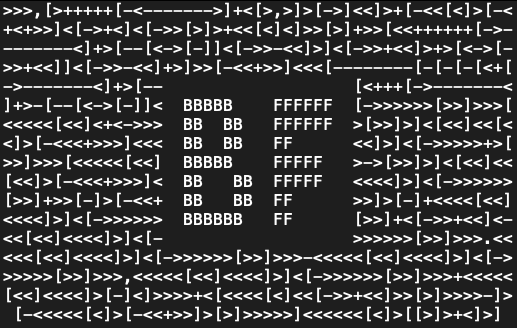Calc 程序简介 nBrainfuck
TI-Nspire 机上 Brainfuck 解释器!
本文由 MaxAlex 编写,所有文字均为原创。
第一章 概述
Brainfuck,是一种由 Urban Müller 在1993年创造的极小化程序语言。该语言只包含八个简单的命令和一个指令指针。
虽然它是图灵完备的,但它的目的并非是为了实际使用,而是为了给程序员们制造挑战与娱乐。只需要把要完成的命令分解成微小的步骤,你就能用这门语言来编写程序。
这种语言基于一个简单的机器模型,除了指令,这个机器还包括:一个以字节为单位、被初始化为零的数组、一个指向该数组的指针(初始时指向数组的第一个字节)、以及用于输入输出的两个字节流。
下面是这八种状态的描述,其中每个状态由一个字符标识:
> 指针加一
< 指针减一
+ 指针指向的字节的值加一
- 指针指向的字节的值减一
. 输出指针指向的单元内容(ASCII码)
, 输入内容到指针指向的单元(ASCII码)
[ 如果指针指向的单元值为零,向后跳转到对应的 ] 指令的次一指令处
] 如果指针指向的单元值不为零,向前跳转到对应的 [ 指令的次一指令处—— 维基百科,自由的百科全书
近日笔者了解到了一些奇奇怪怪的 Esolang,其中的 Brainfuck 语言通过模拟单带图灵机来工作。考虑到这门语言简洁有趣,笔者便产生了将其移植到 TI-Nspire 计算器平台上的想法。
第二章 已有的轮子
说干就干,笔者在 Github 上找到了一个 Brainfuck 的综合仓库,其中包含了一个用 Lua 语言写好的 Brianfuck 解释器。秉着“不重复造轮子”的思想(说到底还是条懒狗),笔者决定在这个现有的解释器的源码上进行修改,使其能够在 TI-Nspire 平台上正常运行。由于德州仪器官方向 TI-Nspire 用户直接提供了 TI-Lua,因此移植起来并不困难。
下面先贴出原版解释器的源码:
1 | -- Copyright (c) 2016 Francois Perrad |
我们不妨先来分析一下这段代码。TI-Lua 中并没有 Lua 的标准输入输出库(io),因此我们不对输入输出的有关行作过多说明。
1 | local f = arg[1] and assert(io.open(arg[1], 'r')) or io.stdin |
我们先来看脚本的第一部分,这里一共声明了三个变量:
f 为代表 Brainfuck 源码的字符串;src 则是对 f 去除非 Brainfuck 操作符后的源码;len 代表源码长度。
1 | local stack = {} |
在这一部分中,解释器将会对处理后的字符串 src 进行处理,分离出单个操作符并存储到 code 数组中。此外,解释器也记录了每个配套的 [ 和 ] 的跳转位置,便于接下来执行时进行跳转。stack 是为了处理嵌套的 [ 和 ] 而设置的变量。
1 | local buffer = setmetatable({}, { |
这一部分是解释器的最后一部分,也是最为核心的一部分。我们首先声明了一个名为 buffer 的表,并通过元表将其初始化为0(可以理解为把表全部填充为0),这便是图灵机中的那条无限长的纸带,而纸带上存储的就是数据;ptr 为纸带的读写头,它存储了当前读写头所处的位置;pc 则是存储 code 数组中当前所执行到的位置,便于在遇到 [ 和 ] 时进行跳转。在 while 循环中,我们逐个读取 code 数组中的各个操作符,并用 if..elseif 结构来处理它们。
第三章 正式实践
上面的这段代码并不能直接复制后在 TI-Nspire 平台运行,因此我们要对其进行一定的修改。为保证最大的兼容性,笔者决定采用 TI-Lua API 1.0 来编写 nBrainfuck。
我们先把原版解释器进行封装,放入 Brainfuck 函数中:
1 | function brainfuck(input) |
在这里,我们声明了一个名为 bfOutput 的变量用于存储 Brainfuck 程序的输出(因为 TI-Lua 仅允许在 on.paint(gc) 中进行绘制)。在遇到 . 标识符时将输出的字符连接至 bfOutput,最后在程序结束后将其返回即可。, 标识符(即输入)的处理相对复杂,我们将在下文中谈到。
由于 TI-Lua 是一门事件驱动语言,所以我们还要引入处理事件的函数:
1 | function on.activate() |
其中,我们在 on.activate 函数中运行解释器,并将用户剪贴板中的内容传入刚刚封装的 Brainfuck 函数。不过,还是由于 TI-Lua 的事件驱动特性,我们转而使用了 Lua 中的协程来处理用户的输入。协程启动后,如果遇到 , 标识符则会挂起协程并返回已有的输出。接下来等待用户按下按键,调用 on.charIn 函数,并将用户的输入传入,重启协程。
第四章 完成
上面简要写出了笔者构建 nBrainfuck 时的思路,具体的程序可前往这里下载体验。
